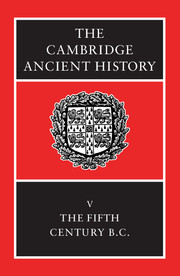Book contents
- Frontmatter
- Contents
- List of maps
- List of text-figures
- Preface
- 1 Sources, chronology, method
- 2 Greece after the Persian Wars
- 3 The Delian League to 449 b. c.
- 4 The Athenian revolution
- 5 Mainland Greece, 479–451 b. c.
- 6 The Thirty Years' Peace
- 7 Sicily, 478-431 b.c.
- 8 Greek culture, religion and society in the fifth century b.c.
- 8a Art: Archaic to Classical
- 8b Classical Cities and Sanctuaries
- 8c Rebuilding in Athens and Attica
- 8d Panhellenic Cults and Panhellenic Poets
- 8e Athenian Cults and Festivals
- 8f Athenian Religion and Literature
- 8g Society and Economy
- 8h Athens as a Cultural Centre
- 9 The Archidamian War
- 10 The Peace of Nicias and the Sicilian Expedition
- 11 The Spartan Resurgence
- Chronological Notes
- Chronological Table
- BIBLIOGRAPHY
- Index
- 1 Greece and Western Asia Minor
- References
8c - Rebuilding in Athens and Attica
from 8 - Greek culture, religion and society in the fifth century b.c.
Published online by Cambridge University Press: 28 March 2008
- Frontmatter
- Contents
- List of maps
- List of text-figures
- Preface
- 1 Sources, chronology, method
- 2 Greece after the Persian Wars
- 3 The Delian League to 449 b. c.
- 4 The Athenian revolution
- 5 Mainland Greece, 479–451 b. c.
- 6 The Thirty Years' Peace
- 7 Sicily, 478-431 b.c.
- 8 Greek culture, religion and society in the fifth century b.c.
- 8a Art: Archaic to Classical
- 8b Classical Cities and Sanctuaries
- 8c Rebuilding in Athens and Attica
- 8d Panhellenic Cults and Panhellenic Poets
- 8e Athenian Cults and Festivals
- 8f Athenian Religion and Literature
- 8g Society and Economy
- 8h Athens as a Cultural Centre
- 9 The Archidamian War
- 10 The Peace of Nicias and the Sicilian Expedition
- 11 The Spartan Resurgence
- Chronological Notes
- Chronological Table
- BIBLIOGRAPHY
- Index
- 1 Greece and Western Asia Minor
- References
Summary
When the Persians had withdrawn, the Athenians returned to find their city mostly in ruins. Rebuilding and new building during the rest of the fifth century fall into three phases, though these are not entirely distinct (Fig. 24). In the earlier years, concern was mainly with housing and defence. There must have been much refurbishing of shrines and public buildings; the erection of major temples had to wait. Several important but modest public buildings were undertaken, notably the Tholos and the Stoa Poikile. Whatever is the truth about the ‘oath of Plataea’ (see p. 206), by which the Greeks are said to have sworn not to rebuild the shrines destroyed by the Persians, peace with Persia (440 b.c.) seems to have led to the phase of far more ambitious temple building at Athens, including the great programme of Pericles. Already in the 440s there are signs that the Athenians had undertaken more than their resources would permit; in the next decade with the inevitable onset of war the difficulties increased. Yet even after the outbreak of war in 431 the impetus was not wholly lost, and the architectural achievements of the troubled decades of the late fifth century, though not on the scale of the Parthenon, are varied and considerable. The work cannot have been confined to the years of uneasy peace following 421, though these no doubt provided occasion for the revival of activity and the completion of abandoned work. One obvious difficulty in years of invasion or occupation of Attica would be transport from the quarries.
- Type
- Chapter
- Information
- The Cambridge Ancient History , pp. 206 - 222Publisher: Cambridge University PressPrint publication year: 1992
References
- 1
- Cited by

